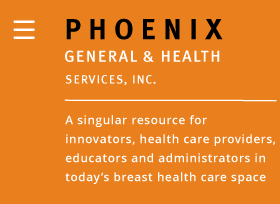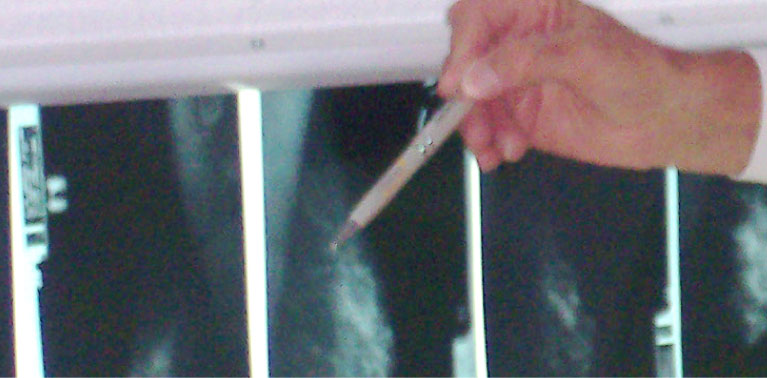THE BREAST EVALUATION CENTER / SAN FRANCISCO:
THE STORY
The office door closes as she turns left to a row of black, pay telephones hanging on the lobby wall. I know this pattern. In just a few minutes there will be that phone call from her physician. I wait before seeing another patient.
“Hi Philip, is what I feel in her breast a cancer?”
The woman whose mammography I have just reviewed is in the lobby on hold. She is waiting to know: “Will I be in the hospital by this afternoon; in surgery this evening? Tomorrow morning, will I still have two breasts? What is my future?” Very likely these are her thoughts while waiting for a voice to return. Her future is on hold.
When I reflect on the frequency of this pattern, I become curious. Why? Mammography patients are the most frequent patients requesting results immediately even though the question is also one of cancer for many other patients.
At that time, medical practice requires that radiologists communicate only with the patient’s physician. If I could gain additional important information about a breast abnormality with an ultrasound examination, a written request from her physician is required. In the 1980’s it is not standard of care for a radiologist to report results directly to a patient or to do any additional imaging without a physician’s written order.
Searching the medical literature going back decades, I am both surprised and rewarded. I know that breast cancer is a major concern for women, but cancer is not the most common breast abnormality! Many benign breast conditions, often mimicking cancer, are much more common. Not only are they not malignant, but they also usually do not need surgery; their management is medical.
No one in the community is currently managing benign breast conditions medically. Every patient with a breast mass or problem is immediately referred to a surgeon. Strong evidence for excellent symptomatic relief for and management of benign abnormalities is in the literature. The most significant is the evidence that surgery can and should be avoided.
COINCIDENTALLY
Professor Umberto Veronesi, a Milanese surgeon, published an excellent, prospective study which creates the first paradigm shift in breast surgery for decades. This seminal study, from the Tumor Institute of Milan, has data that limited breast tissue removal (partial mastectomy) could provide the same patient survival as complete breast removal (mastectomy – which is the standard since 1895). Mammography is critical for patient selection. Imaging identifies women eligible for “breast conservation surgery” - as it is now called.
SIMULTANEOUSLY
Equipment developments improve breast imaging, identifying smaller cancers and more easily defining benign lesions. CGR, a French company, receives FDA approval for the first modern, low-dose radiation mammography machine.
THE VISION
A SINGULAR BREAST HEALTH AND IMAGING FACILITY CONCEPT:
- The word “cancer” should not be in our Center’s name. So many conditions are benign. Emotionally important. Therefore, the word, “Evaluation”.
- Complete all necessary imaging services in one visit.
- The radiologist informs the patient of all results at the conclusion of the visit as well as sending reports to the physician.
- The radiologist should be knowledgeable in all aspects of breast healthcare.
- The radiologist should perform a clinical breast examination prior to imaging.
- Accept patients (men as well as women) who have no physician as well as patients referred by physicians.
- The radiologist takes responsibility for a patient’s breast care if there is no referring physician (self-referred).
- Manage benign breast diseases for patients who do not need surgery.
- Educate patients. (What is normal? What are benign conditions? What are the facts about breast cancer?)
- Teach patients the value of breast self-examination/breast awareness. (How to do it correctly and when.)
- Create support groups for women diagnosed with breast cancer. Also create support groups for family members and/or caregivers.
- Each patient’s care is a partnership between a knowledgeable physician and an informed patient.
- Be a primary care center for all breast care.
REALITY
The BEC/SF opens:
The Breast Evaluation Center/San Francisco opens as a primary care facility for the breast – the first of its kind with a comprehensive array of services never before offered in one facility. October 14, 1980
- THE FIRST – using modern, low-radiation-dose mammography equipment, — FDA approved automated whole breast water-bath ultrasound, — offering pre-operative needle localization, — Fine Needle Aspiration (FNA) cytology for lesions that can be felt or ultrasound imaged, and — ductography (galactography).
- THE FIRST – to provide medical management for all benign breast diseases/conditions.
- THE FIRST – to allow a patient without a physician to make an appointment or to be referred by her/his physician.
- THE FIRST to provide referrals to fully vetted surgeons, oncologists, plastic surgeons or counselors when the patient has no physician.
- THE FIRST to perform all breast imaging and procedures in one visit.
- THE FIRST to provide results directly to the patient at the conclusion of the visit.
- THE FIRST to provide recommendations for further care directly to the patient.
- Reports are sent to the patient’s physician.
- THE FIRST breast imaging facility to offer LOW-COST SCREENING MAMMOGRAPHY. (Screening mammography is not covered by insurance at this time.)
- Nipple aspirate Pap smear examination.
- Patient education including one-on-one breast self-examination (BSE)
- Support groups for women diagnosed with breast cancer, their family members and care givers.
The center very shortly acquires new equipment: X-ray stereotactic needle biopsy table (recently FDA approved) allowing Fine Needle Aspiration (FNA) under x-ray guidance for abnormalities which cannot be felt or seen with ultrasound.
BEC/SF is an early adopter of prevention programs offering exercise classes, stress reduction information and cooking classes with practical, tasty low-fat recipes.
Physicians visit to see and understand this new concept. Some go home and implement a few of our practices: some even borrow our unique and purposefully created name!
Over the years, patients from Alaska, Panama, Florida, and New York City find their way to the Breast Evaluation Center/San Francisco.
Contact: pghs456@gmail.com.


